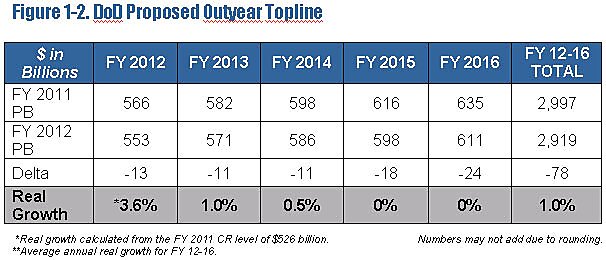Last week I expressed my disappointment with Paul Ryan’s budget plan, specifically about his unwillingness to cut military spending. Some people think that he does cut spending through his acceptance of Secretary Gates’s $78 in “cuts.” (see, for example, Sen. John Sununu; Sen. Joseph Lieberman, AEI’s Gary Schmitt and Tom Donnelly; and the Heritage Foundation’s Baker Spring).
So either I am wrong, or they are. Let me try to set the record straight.
First, all of Ryan’s other savings — savings which I support — were projected either against the Obama administration’s FY 2012 budget or against the current budget baseline. For example, according to Ryan’s own “Key Facts” his plan “Cuts $6.2 trillion in government spending over the next decade compared to the President’s budget, and $5.8 trillion relative to the current-policy baseline.” With respect to military spending, however, Ryan’s plan basically follows the Obama/Gates budget, proposing to spend a staggering $670.9 billion in FY 2012. The Obama administration’s DoD budget request for FY 2012 — including the Pentagon’s base budget plus overseas contingency operations (OCO) — totals $670.9 billion as well. Of course, that total leaves out national defense spending tucked away in other departments (including nuclear weapons spending in the Department of Energy). Total national defense spending in FY 2012 will top $700 billion. I stand by my earlier assertion that the Pentagon’s budget escapes from Ryan’s budget axe “essentially unscathed.”
Ryan and others claim that military spending has already been cut, hence the decision to embrace this portion of the president’s budget. Sen. Lieberman explained to Bloomberg news, “To a certain extent, Secretary Gates has enabled us at least temporarily to take defense off the table because he has initiated his own round of defense cuts.”
“To a certain extent” is doing a lot of work in that statement. In fact, Gates and Obama do not cut military spending.
First, they don’t claim to do so. These supposed cuts are only “cuts” in Washington-speak. The Pentagon’s base budget under both the Ryan and Obama plans will increase 1 percent in real, inflation-adjusted terms. See the table below, recreated by my colleague Charles Zakaib from the official DoD budget request.
Second, Ryan claims that Gates’s “exhaustive review of the Pentagon’s budget” identified $178 billion in savings. It does nothing of the sort. By Ryan’s own admission, taxpayers will see only $78 billion of these; the other $100 billion are to be “reinvested” elsewhere in the Pentagon. (They’re always “investments” when you’re spending the taxpayers’ money, even when Republicans do it.)
So we’re really talking about $78 billion toward deficit reduction over the next five years, or approximately 2.6 percent of the Pentagon’s base budget (excluding the wars) over that same period. With all due respect, that isn’t a bold plan for reducing the crushing burden of spending and debt; that’s a rounding error.
What’s more, it is highly unlikely that these savings will materialize. Many of these efficiencies involve consolidation of commands — something that Congress has already balked at — and unspecified savings that are relatively easy to identify, but extremely difficult to implement.
But if, by some miracle, Robert Gates’s successor(s) manage to get them passed by Congress, those savings won’t actually be dedicated to deficit reduction: they will be completely devoured by spending on the wars. This is the greatest sham of all. Charles Knight at the Project on Defense Alternatives (and a key contributor to the Sustainable Defense Task Force, of which I was also a member) explains:
For several years now White House budget projections have included a “placeholder for outyear overseas contingency operations” most of which are accounted for by the wars in Iraq and Afghanistan. This placeholder number has been and remains $50 billion. Every year actual OCO (overseas contingency operations) spending turns out to be several times that number. FY11′s OCO is $159 billion and FY12′s is $118 billion.
Adjusting for the effect of the new OCO for FY12, the $68 billion budgeted above the placeholder of $50 billion eats up most of the $78 billion in Pentagon cuts that Secretary Gates offered up in January to fiscal responsibility….The remaining $8 billion (and much more) will go to the war budgets when reality collides with placeholder projections.
On 14 February Pentagon Comptroller Hale confirmed that the $50 billion placeholders for FY13 and beyond was the “best we can do.” Others make an attempt to be more realistic. The high tech industry association called Tech America annually projects DoD budgets for ten years out. In their 2010 projection they estimate that OCO spending will be $102 billion in FY13, $69 billion in FY14 and $57 billion in FY15. When we subtract the $50 billion placeholder for each of those years and total the remainder we find that the Pentagon is likely to spend $78 billion more in the years FY13 through FY15 than in the White House budget projections.
I hope that I’m proved wrong. I hope that the wars in Iraq and Afghanistan are brought to a close. I hope that the Congress gets serious about tackling Pentagon waste, and stops treating the military budget as an elaborate jobs program. I hope that our brave men and women in uniform get the hardware, equipment, and training that they need, and that Americans get the “defense budget” that they deserve. But if past history is any guide, the Pentagon’s budget will continue to climb, other countries around the world will continue to free ride on Uncle Sam’s largesse, and U.S. taxpayers will be left to foot the bill.

